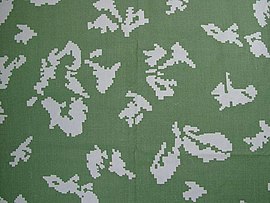Kamuflirovannyi Letnyi Maskirovochnyi Kombinezon
| Kamuflirovannyi Letnyi Maskirovochnyi Kombinezon | |
|---|---|
 | |
| Type | Military camouflage pattern |
| Place of origin | Soviet Union |
| Service history | |
| In service | 1968–present |
| Used by | See Users |
| Wars | |
| Production history | |
| Designed | 1968 |
| Produced | 1968–present |
| Variants | See Variants |
The Kamuflirovannyy Letniy Maskirovochnyy Kombinezon[1] (Russian: Камуфлированный Летний Маскировочный Комбинезон, lit. 'Camouflaged Summer Disguise Coverall')[2] or KLMK is a military uniform with a camouflage pattern developed in 1968 by the Soviet Union to overcome the widespread use of night vision optics and devices by NATO countries.[3] This one-piece camouflage coverall became one of the most widely used in the Soviet Union.
As of 2018[update], the KLMK two piece camouflage suit is being produced.[3]
History
[edit]
The KLMK was issued to KGB Border Guards in service dress uniforms.[4] It was later seen with their forces sent to Afghanistan during the Soviet–Afghan War.[5]
Description and versions
[edit]Birch camouflage is 2-color design and consists of light angular ("toothed") spots in the shape of leaves on a green-olive background.[6] The standard camouflage pattern exists in two color versions: with spots of light gray color; with spots of yellow-sand color (this version was used mainly by KGB border guards). The background color of both variants is olive, sometimes there are swamp-colored specimens. In any case, the background in this color scheme is always darker than the spots. The spots themselves have "angular" edges consisting of many small squares. The KLMK is made with a digitalized spatter-like pattern.[7]
-
Closeup of KZS showing burlap-like fabric
-
Yellow variant worn by Ukrainian soldier
-
yellow variant worn by KGB Border Troops
-
White KMLK wearing Ukrainian officer briefing white KZS wearing Ukrainian troops during exercise Rapid Trident 2013
Variants
[edit]KZS Suit
[edit]The KZS (Russian: костюм защитный сетчатый or kostium zashchitnoi seti, English: or protective net suit) is a two-piece camouflage suit, designed for use by chemical troops. Made of coarse loose weave cotton fabric (possibly burlap).[2] It was first issued to Soviet chemical troops in 1975[2] and was later widely used by troops from all combat arms, especially during the Afghan war.[7]
The KZS was made to be disposable once used in a chemical environment it cannot be used any longer.[7]
It is also known as the Berezka (birch), Color 57,[8] or serebryanyi list (silver leaf).[9]
Users
[edit] Armenia[10]
Armenia[10] Azerbaijan[11]
Azerbaijan[11] Belarus: KLMK and KZS-type camos used by Belarusian special forces.[12] KZS camos used by Belarusian border guard forces in public appearances.[13]
Belarus: KLMK and KZS-type camos used by Belarusian special forces.[12] KZS camos used by Belarusian border guard forces in public appearances.[13] Kyrgyzstan[citation needed]
Kyrgyzstan[citation needed] Russia: KZS used by Spetsnaz and VDV[14] plus Engineer & Cossack units of the Russian Army.[9]
Russia: KZS used by Spetsnaz and VDV[14] plus Engineer & Cossack units of the Russian Army.[9] Tajikistan: Berezhka-based patterns used by Tajik Border Guard.[15]
Tajikistan: Berezhka-based patterns used by Tajik Border Guard.[15]
Former
[edit] Republic of Afghanistan: Issued to Officers and Commando Paratrooper units.[16][17][18]
Republic of Afghanistan: Issued to Officers and Commando Paratrooper units.[16][17][18] Soviet Union: Known to be used by the KGB Border Guards and the VDV.[1][4]
Soviet Union: Known to be used by the KGB Border Guards and the VDV.[1][4] Ukraine: Seen with KLMK pattern-based camos.[19]
Ukraine: Seen with KLMK pattern-based camos.[19]
Partially-recognized states
[edit] South Ossetia: Used by pro-Russian irregulars during the 2008 Russian-Georgian War.[20]
South Ossetia: Used by pro-Russian irregulars during the 2008 Russian-Georgian War.[20]
References
[edit]Citations
[edit]- ^ a b Zaloga (1985), p. 56.
- ^ a b c "Trousers, Camouflage, M1975 KZS: Soviet Army". Archived from the original on 8 September 2017. Retrieved 1 April 2020.
- ^ a b "KLMK - the Soviets Did Digital Camouflage First - Soldier Systems Daily". Soldier Systems Daily. 1 March 2018. Archived from the original on 26 September 2019. Retrieved 28 February 2023.
- ^ a b Zaloga (1985), p. 27.
- ^ Isby (1986), p. 40.
- ^ Galeotti, Mark (2013). Russian Security and Paramilitary Forces since 1991. Osprey Publishing. ISBN 978-1780961057.
- ^ a b c Dougherty (2017), p. 70.
- ^ "Russian Camo: What Camouflage Does Russia Use ?". April 2020. Archived from the original on 25 February 2023. Retrieved 25 February 2023.
- ^ a b "Russia - Camopedia".
- ^ Larson (2021), p. 194.
- ^ Larson (2021), p. 198.
- ^ Larson (2021), p. 335.
- ^ Larson (2021), p. 358.
- ^ "USSR - Camopedia".
- ^ Larson (2021), p. 328.
- ^ Afghanistan - Rebels Without A Cause (1989), retrieved 26 June 2023[better source needed]
- ^ TiltedTowersAfg (8 April 2023). "A Afghan Commando Paratrooper in a KLMK suit, Democratic Republic Of Afghanistan, 1980s [1364x2048]". r/MilitaryPorn. Retrieved 26 June 2023.[better source needed]
- ^ "General Khushal distributing medals to the members of the Afghan National Guard after the Battle of Jalalabad (1989) [750x749]". r/MilitaryPorn. 24 July 2022. Retrieved 28 June 2023.[better source needed]
- ^ "Ukrainian M14 Digital Pattern". joint-forces.com. 5 October 2019. Archived from the original on 30 November 2022. Retrieved 28 February 2023.
- ^ Galeotti (2013), p. 56.
Works cited
[edit]- Dougherty, Martin (2017). Camouflage at War: An Illustrated Guide from 1914 to the Present. London, UK: Amber Books. ISBN 978-1782744986.
- Galeotti, Mark (2013). Russian Security and Paramilitary Forces since 1991. Osprey Publishing. ISBN 978-1780961057.
- Isby, David C. (1986). Russia's War in Afghanistan. Osprey Publishing. ISBN 978-0850456912.
- Larson, Eric H. (2021). Camouflage: International Ground Force Patterns, 1946–2017. Barnsley: Pen & Sword. ISBN 9781526739537.
- Zaloga, Steven (1985). Soviet Bloc Elite Forces. Osprey Publishing. ISBN 978-0850456318.
External links
[edit] Media related to Beryozka at Wikimedia Commons
Media related to Beryozka at Wikimedia Commons





